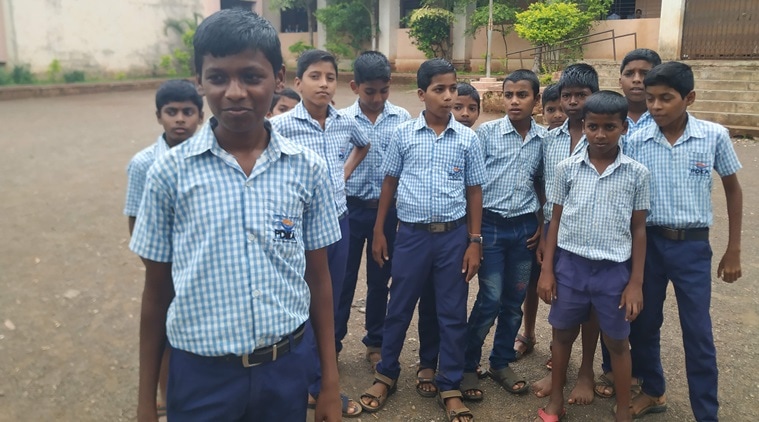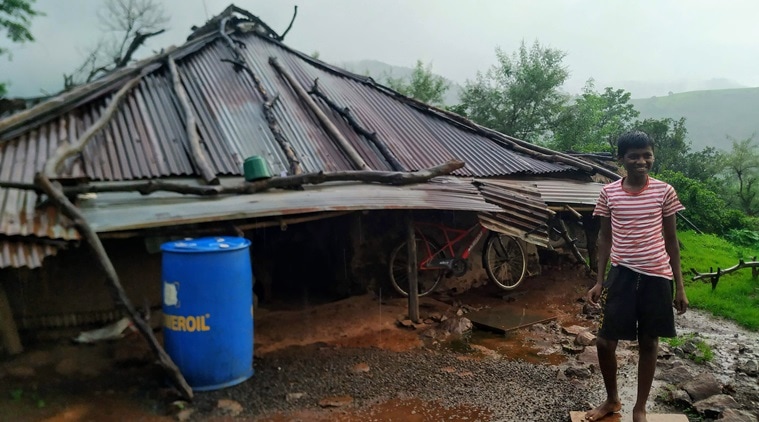Pune: This boy walked 11 km to school every day and scored 82% in Class 10
Ananta has already set himself the goal of becoming an IAS officer.
Written by
Atikh Rashid | Pune |
Updated: August 1, 2020 4:32:13 pm
Pune: Ananta Doiphode, 16, used to walk 22 kilometers to-and-fro daily to access education in a school in Panshet village. (Photo Source: Atikh Rashid)
Sixteen-year-old Ananta Doiphode had to walk 22 kilometers to-and-fro daily to access education in Panshet, a remote area in Maharashtra’s Pune district. Most would find this routine exhaustive, Ananta did too. But he tried not to let the fatigue affect his studies—quite successfully.
On Thursday, his efforts paid him rich dividends as he scored an impressive 82.80 per cent in
Class 10 examination of the Maharashtra State Board.
“I used to wake up at 4 am and study till 6. Then sleep for an hour before waking up and leaving on foot to the school,” Ananta told
The Indian Express. “After returning from school, I studied late night every day,” he said, adding: “I knew it was an important year for me.”
Ananta is the oldest among three siblings who reside with their mother in an old, tiny m&d-house. His father works as a waiter in a canteen. The house is dark even during the day. There’s no fan in the house.
Not satisfied with his performance, Ananta has already made plans for his long-term goal. “I will go to Pune city for junior college. I want to prepare for UPSC to become a civil servant.”
Read | Maharashtra SSC results: Peon’s daughter who had to borrow books to study for exams scores 98.2%
“I was hoping to score 90 per cent. I may have achieved that had I stayed at the hostel near my school. But we didn’t have money. Walking four hours a day tired me out,” he rued.
The family stays in Varghad village of Velha tehsil, which is barely 60 kilometres from Pune city. However, it is located in the hilly part of the district that is topographically closer to coastal Konkan than plains of the rest of the state. The village has a population of over a thousand but barely 50 families have stayed back as most of them chose to migrate to cities for a better life.
Ananta in front of his house in a remote village called Varghad in Pune. (Photo Source: Atikh Rashid)
Children can study until Class 7 at a Zilla Parishad-run primary school located within the village. The closest school, where Class 8 to 10 education is available, is in Panshet, which is 11 km away. Ananta studied at this school.
He was one of the three students from the village who used to walk to the school every day. There’s a bus that connects Varghad and other villages on the route with Pune and can be used by children to go to school, but it has odd timings that are not suitable for school.
“The bus service is not reliable. In the morning, the bus reaches Panshet very early and in the evening there’s no fixed time as it may arrive at 6 pm or 10 pm. Hence, students and others often choose to walk than to wait for the bus,” said Ananta’s mother.
The students said that a lot of them can’t afford the monthly fee for the bus pass. “The bus pass for boys is expensive about Rs 660 per month. For girls, it is just Rs 30. Also, we need to go to Swargate (in Pune city) to make the pass, making it inconvenient and more expensive,” said Avishkar Pasalkar, Ananta’s classmate.
Some days when the kids have money and if the bus turns up on time, they take the bus ride. But that’s rare, they say.
The Swargate Depot Manager of Maharashtra State Road Transport Corporation (MSRTC) attributed limited bus service in the village to “lack of demand”.
Read | Maharashtra SSC 10th results 2020: NFBM Jagriti school for blind girls secures 100% results once again
“The buses in this area get very few passengers. The only service we run to Tekpol is suffering losses,” said DM Shinde.
The migration to Pune or Mumbai has thinned out most of the villages in Velha as has been the case with other hilly tehsils in Mulshi, Bhor, Maval and Purandar. However, its worst impact has been on the education of children in those families who have stayed back in the area. The number of students enrolled per school has gone down drastically every passing year. As per data obtained from Pune Zilla Parishad’s Primary Education Department, as many as 60 primary schools run by ZP have been closed down in the district due to lack of students.
Of the 3652 primary schools that were operational in the district in the academic year 2018-19, as many as 379 schools— mostly in the hilly talukas mentioned above— had less than 10 students. “This obviously affects the quality of education in these schools as most of these school are now run by a single teacher,” said an official with Pune ZP’s education department.
At Shri Shivaji Vir Baji Pasalkar High School in Panshet, where Ananta is a student, there are many like him who walk many kilometres to school in the absence of transport facility. “We have students who walk 10 to 22 km every day. These are very poor people who can’t even afford the concession passes. There are many villages which have no bus connection,” said Asha Kutwal, a teacher at the school.
Ananta’s teachers remain hopeful about his future and fondly remember him as the “brightest” student in his class who performed exceedingly well despite the many hurdles.
Subscribe to receive the day's headlines from The Indian Express straight in your inbox






